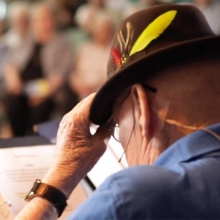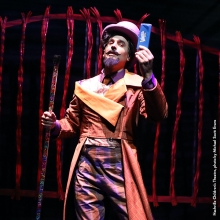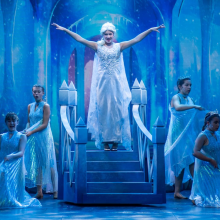Filichia Features: Aida, Radames and Amneris

Filichia Features: Aida, Radames and Amneris
In Casablanca Rick tells Ilsa “The problems of three little people don’t amount to a hill of beans in this crazy world.”
But the problems of three big people result in one of musical theater’s strongest books.
As Gary John La Rosa’s excellent production of Aida at Montclair State University reiterated, librettists Linda Woolverton, Robert Falls and David Henry Hwang should have called their musical Aida, Radames and Amneris, for it’s about all three.
 Aida at Montclair State University: Department of Theatre & Dance (Photo by Gennadi Novash).
Aida at Montclair State University: Department of Theatre & Dance (Photo by Gennadi Novash).
What other musical has no villains among its three main characters? Two make an excellent case for royalty: Aida and Amneris are princesses (in the best sense of the word); Radames will be a prince-by-marriage once he weds his long-betrothed Amneris. The closest we have to bad guys are their three fathers. Even a minor character – Nehebka – makes a noble sacrifice.
Still, the librettists can justify their title: Aida is a great musical theater heroine. This Nubian princess has been captured and handcuffed by the Egyptians, and yet she still manages to grab a soldier’s sword from his sheath and place it to his neck, ready-to-slice.
No wonder that Radames is impressed.
But that isn’t Aida’s only asset: she improves people. Her fortitude and wisdom make this Egyptian princess eventually say to her “You’re my friend” and this Egyptian warrior ultimately kneel to her – and love her.
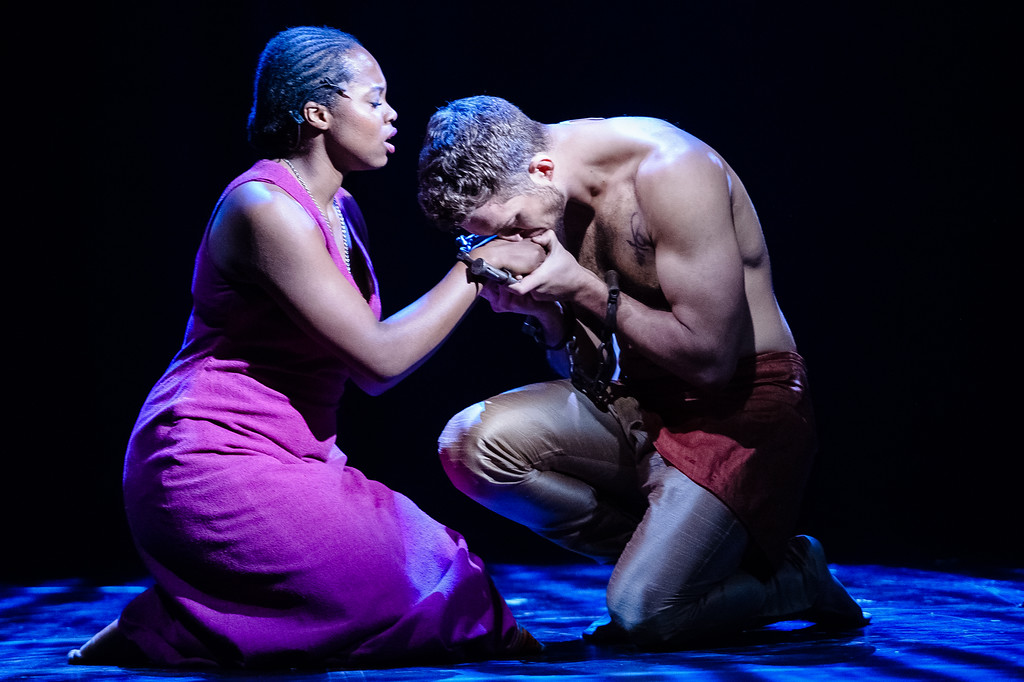 Aida at Montclair State University: Department of Theatre & Dance (Photo by Gennadi Novash).
Aida at Montclair State University: Department of Theatre & Dance (Photo by Gennadi Novash).
When Aida debuted in Atlanta, an elaborate pyramid just wouldn’t cooperate. So the pyramid scheme was dropped – which was fine, for the strong story doesn’t need it. La Rosa showed that a unit set, a second level and a staircase worthy of Dolly Levi swings it.
Well, you DO need a sign that plainly states that the show starts in a contemporary museum. Theatergoers naturally assume Aida takes place way-back-when, so let them clearly know where they are before you show them where they’re going.
Considering the short life-span of those who lived in 2856 B.C., college kids are age-appropriate. Virginia Vass had Aida’s required strength, including her taking full responsibility for getting herself and her entourage captured. What shame she expressed when she recounted that she disobeyed her father’s warning “to not go into lands where you should not go.” Yet she rallies them when all looks lost (via a stirring Elton John-Tim Rice anthem).
Then comes the agony when her father tells her “You will cut this man from your heart.” We understand his point-of-view; Egyptians have been non-stop horrible to him. What he can’t know, see or acknowledge is that Aida has changed two people in power.
Still, Vass displayed the anxiety in knowing future problems and the bigger picture while Radames doesn’t. She wants him to free her people; he’s worrying about their relationship.
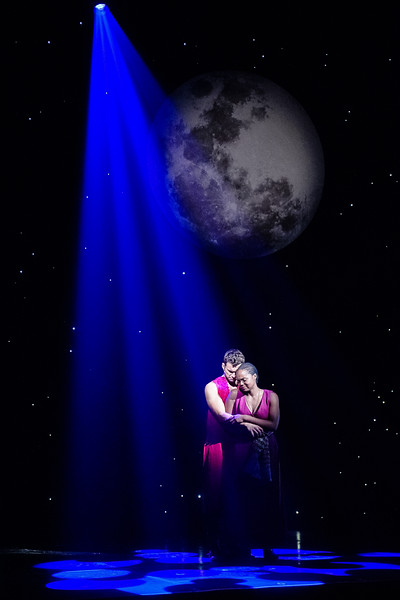
Aida at Montclair State University: Department of Theatre & Dance (Photo by Gennadi Novash).
Ian Laudano gave Radames a straight-out, beautiful voice. Take note: your Radames needn’t have the gravelly, raspy sounds favored by pop stars. Also ensure that he, like Laudano, fully expresses outrage when his father tells him to marry Amneris and cheat with Aida. Radames wants to be better than his father who’s blithely unfaithful to his wife.
Kristina Walz’s impressive Amneris charted her remarkable growth. When for the first time she railed against war, she was condescendingly told that these conflicts were responsible for her beautiful jewelry. How we admired Amneris when Walz poignantly said “Suddenly it doesn’t look so beautiful.”
Make certain your Amneris attains Walz’s subtle awareness that Radames doesn’t love her. That she accepted it without self-pity and excuses made us feel for her.
Actually, Radames does love her – except that, as A Class Act’s song goes, it’s “The Next Best Thing to Love” – meaning a truly deep and loving friendship. (Well, they have been engaged for nine years. Love often has short shelf-life during long engagements).
La Rosa made Amneris’ handmaidens unique individuals with different reactions when Aida stood up to her: horrified, scared, impressed, confused -- and not just waiting for their next cue. Ditto in “My Strongest Suit” when they were dressing Amneris: attentive, bored, jealous and contemptuous.
Once they finished, Amneris had her dress – which lit up. How did they do that?
Says La Rosa, “Student costume designer Cheyenne Pellicoro and our costume shop used LED lights that were controlled wirelessly. A wire frame and boning held the lights in place.”
A foot-high square with jagged edges (by designer Michael V. Moore) was enough to suggest the tomb in which Aida and Radames would be buried alive. “There’s another world waiting for us,” he says, and indeed there is. We return to that museum where a reborn Aida and Radames re-meet.
This is a smart way of lessening a sad ending, which will please your audience – especially the reincarnation buffs.
You may e-mail Peter at pfilichia@aol.com. Check out his weekly column each Monday at www.broadwayselect.com and Tuesday at www.masterworksbroadway.com. His book, The Great Parade: Broadway’s Astonishing, Never-To-Be Forgotten 1963-1964 Season is now available at www.amazon.com.





















